
The Basics:
- For ages 8 and up (publisher suggests 12+)
- For 2 to 4 players
- Approximately 60 minutes to complete
Geek Skills:
- Active Listening & Communication
- Counting & Math
- Logical & Critical Decision Making
- Reading
- Strategy & Tactics
- Cooperative & Team Play
- Hand/Resource Management
- Worker Placement & Area Control
Learning Curve:
- Child – Easy
- Adult – Easy
Theme & Narrative:
- The City is yours to destroy or to save…
Endorsements:
- Gamer Geek approved!
- Parent Geek approved!
- Child Geek approved!
Overview
In the action movie Kick-Ass, the fictional character Dave Lizewski said, “In the world I lived in, heroes only existed in comic books. And I guess that’d be okay, if bad guys were make-believe too, but they’re not.” In the world of comic books and in real life, there are always opposing forces. In this game, players become heroes or villains and battle for dominance.
Villains and Vigilantes, designed by Ben Swainbank and published by Superhuman Games, is comprised of 2 “Hero” Player decks (60 cards each), 2 “Villain” Player decks (60 cards each), 1 Location board, 4 Capture tokens, 4 Destroyed tokens, 1 Fade token, 4 Headquarters tokens, 16 Plot tokens, 2 Slash tokens, 1 Trap token, 5 Battery counters, 25 Body Damage counters, 15 Mind Damage counters, 10 Drain counters, 25 Mojo counters, 10 Recovery counters, 12 Character stand-ups, and 20 Character bases (that help them stand up). The Location game board is of excellent quality, being both sturdy and illustrated to look like different locations in a comic book. The cards are as durable as your standard playing card and are filled with illustrations of the various Heroes and Villains found in the game jumping over buildings, attacking each other, and doing other super things. The tokens are all made of sturdy cardboard.
A New Day in the City
To set up the game, first give each player 1 or more “Hero” or “Villain” Player decks. In a 2-player game, each player will be either controlling both “Hero” Player decks or “Villain” Player decks. In a 3-player game, 2 players take 1 “Villain” Player deck each and 1 player takes both “Hero” Player decks. In a 4-player game, each player takes 1 Player deck. Do not shuffle the decks together.
Interestingly enough, the number of players in the game and which faction is selected determines how the game will be played to a certain degree. For example, in a 2-player game, the game play is just about the good guys against the bad guys. In a 3-player game, the good guys are attempting to thwart the bad guys, but the bad guys are not working fully as a team. A 4-player game is all about team work, with the good guys going against the bad guys.
Second, the Player decks are designed to focus on specific Heroes and Villains. Quickly look through the deck and identify which Heroes or Villains it contains. Find the matching Character stand-up and attach a base to each.
Third, place the Location board in the middle of the playing area. Each player should find their 3 Mission cards, select 1 as their starting mission, and place it face-up in front of them. The Character stand-ups are placed next to the Mission card.
Fourth, give each player a Headquarters token. Then players place their Headquarters token on the edge of the Location board. Heroes go first by placing 1 of their Headquarters tokens followed by 1 Villain Headquarters token, alternating until all Headquarter tokens are placed. If playing a 4-player game, the 2 Heroes or 2 Villains can elect to play their Headquarters tokens at the same time. The only Headquarters token placement restriction is spacing. Headquarters tokens cannot be within 3 or less Location blocks from an opposing Headquarters token.
Fifth, each player now places their main Character stand-ups in their Headquarters and adds 1 Mojo counter to their starting Mission card. Each player takes all their Support Power cards and places them face-up in front of them to create a Support Power draw deck.
Sixth, each player shuffles their remaining cards and then deals their starting hand. The number of cards drawn is based on the number of Heroes or Villains controlled by the player. The remaining deck is placed face-down to become the player’s Action draw deck. Leave room for a discard pile.
That’s it for game set up. Determine who will go first and begin to save or take over the city.
The Anatomy of a Super
There are a number of cards in the game that play specific and significant roles. Each are summarized here.
Hero and Villain Cards
Each super powered Hero and Villain (commonly referred to as a “super”) has their own card. These cards detail the super’s name, affiliation (Hero or Villain), power, skills, and stamina.

The Powers a super can have range from elemental based abilities to high-tech devices. The specific Powers for the Hero or Villain is noted on their card with icons. A Power can have up to 3 different levels. Enhanced, Superhuman, and Extremely Powerful.
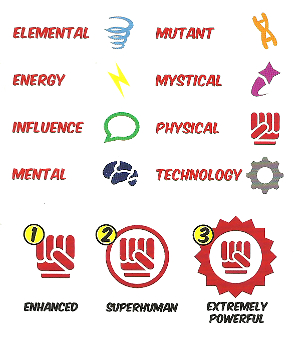
The Skill attribute value determines the super’s overall mastery of their abilities. In game terms, the Skill attribute value identifies how many Power cards can be played.
The Stamina attribute value determines how much damage the super can take before they are knocked out. The higher the Stamina, the tougher the super is to put down.
Power Cards
The Power cards represent the different special abilities the supers use for good or evil. Each Power card lists the Power type that the super must have if they are to use it and the Drain. Drain indicates by how many points the super’s Skill attribute value will be reduced. If the super is unable to pay for the Power card, it cannot be used. If the super can, the listed effect takes place.
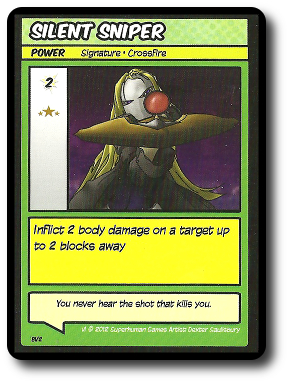
Minor Character Power Cards
The supers are not alone in the City. Minor characters are introduced throughout the game that will assist them in their missions. By using the minor character, a player can cover more territory in the City. Minor Character cards are a type of Power card, with a listed Power type and Drain. Like Power cards, if a player is unable to pay for the Minor Character card, it cannot be played. If they can, the minor character comes into play and is used very much like a super.
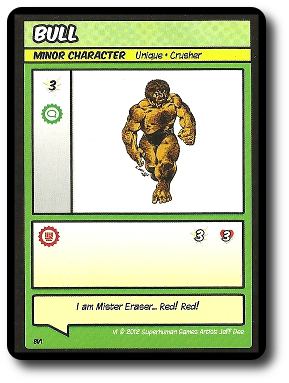
Mission Cards
The Mission cards provide direction and are the only means to victory. Each Mission card lists a condition that must be met. If the player is able to successfully meet the condition on their Mission card, the player earns a Mojo token. Collect enough Mojo tokens and the player wins the game.
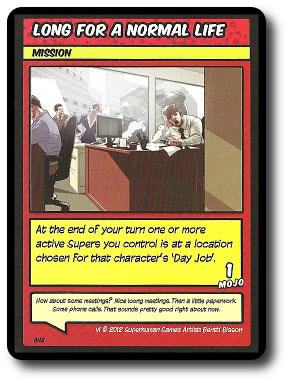
Plot Cards
The Plot cards add permanent events and objects into the game that are used to assist in completing Mission cards and changing the face of the City. Plot cards are not randomly played, but are instead part of a player’s deck of cards. This means a player can decide when to introduce the Plot card into the game. Plot cards remain in front of the player when played and their general area they effect in the City are tracked by placing a token that matches the player’s Headquarter token’s color.
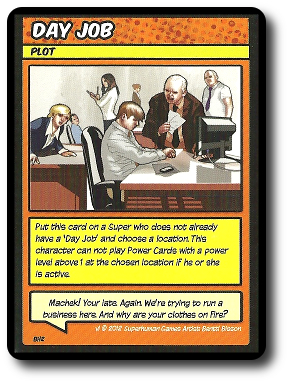
Support Power Cards
While a Hero or a Villain is certainly imbued with incredible powers, they also must make use of many mundane abilities, as well. For example, traveling to another part of the City or swinging a punch. The Support Power cards represent the less powerful and more utilitarian actions, but are no less important to a player’s success. These cards are substituted for Power cards during a player’s turn, forcing a player to consider the pros and cons of shooting lasers out of their eyes versus traveling to a location that needs their assistance.
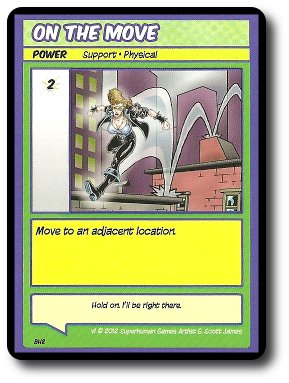
Counters and Tokens
Villains and Vigilantes includes a number of counters and tokens that are not immediately used in the game. Cards will call for certain events to be tracked or counters to be placed. While not every counter and token is used in a game, they are all useful and help players keep the game play organized.
Welcome to the Mean Streets
Combat takes places in the City where the players have their Character stand-ups. The Location board in the middle of the player area has spaces that represent different sections of the City that are being contested by the opposing forces. Movement about the City is done through Power and Support Power cards. A player will most likely move to confront an opponent or to fulfill a Mission card.
Each section is referred to as a “Location” or “Block” and has a unique name and a trait which is referenced on various cards.

This helps players quickly find where some cards are placed or where a super should travel to. All travel in the game is done horizontally or vertically. Never diagonally. When traveling, players move “blocks”, where 1 “block” is to any adjacent Location.
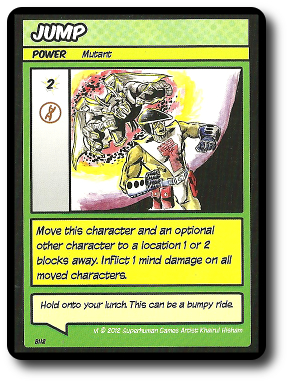
Players will battle each other in the City and can most of the time only do so by being within the same Location as their opponent. Moving about the City then becomes a necessity if players want to take down the bad guys or get away from a fight they cannot win. When a super is damaged, they will either be physically or mentally hurt. Counters are used to keep track of how much damage of each type the super has been dealt. If a super’s combined mental and physical damage is ever equal to or higher than their Stamina, then they are knocked out. Knocked out supers are still in the game and can continue to be targeted, taking additional damage. Minor characters, however, are immediately discarded.
Game play wise, a player is unable to play most cards to a knocked out super. There are a few cards that can be played to knocked out characters, however, so a player is not completely out of options. Healing the super so their total damage is less than their Stamina brings them back into the game.
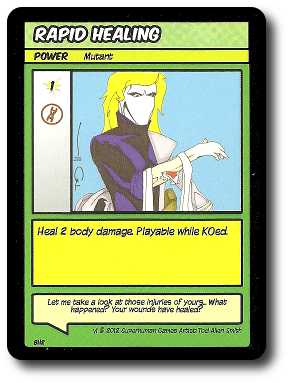
Trouble Is Brewing…
Villains and Vigilantes is played in turns with no set number of turns per game. The Villain players go first followed by the Hero players. Thematically speaking, this suggests that the Heroes are responding to a call for help. Both Heroes and Villains resolve their turn following the same 3 phases. Whenever a player plays a card, a new one is immediately drawn from the Action draw deck. In this way, a player always has the same number of cards in their hand to choose from.
Phase 1: Get Ready
This portion of the player’s turn gives them a moment to look through their Support Power draw deck. The player can take as many Support Power cards as they like and add them to their hand, but they must discard down to their initial hand size. As such, for every Support Power the player adds to their hand, they must discard 1 other card already in their hand. When the player is satisfied they have the right cards in their hand, they can continue to the next phase.
Phase 2: Time for Action or Milling About
The player has two options during this phase, but only one of options can be taken per turn.
Option A: Take Actions
If the player elects to take this option, they can now play Power, Support Power, Plot, Minor Character, and Mission cards.
Power, Support Power, Plot, and Minor Character cards are played directly from the player’s hand and next to the Character stand-up located in the City that the card is being played on. The effect on the Power card is then announced and applied. Before doing so, however, the super must have a Power type with a value equal to or higher than the same Power listed on the card.
A player may play as many cards as they like to a super as long as the total Drain of all cards played does not exceed the super’s Skill value.
Only 1 Mission and 1 Plot card can be played during a player’s turn. There are no limitations on the number of Minor Character cards that can be played, but the minor character is not brought into play during this phase of the player’s turn.
Cards with the keyword “Response” cannot be played on a player’s turn. These cards can only be played during an opponent’s turn as a defensive action.
Option B: Reshuffle
If the player does not want to play or cannot play any cards during this phase of their turn, they can take their discarded Power cards and shuffle them back into their Action draw deck.
Phase 3: Swipe and Cleanup
This phase of the game focuses on cleaning up and organizing the playing area.
- Played Power cards are placed in a discard pile. These cards are out of play until the player shuffles them back into their Action draw deck. This discard pile is referred to as the “Swipe pile”.
- Played Support Power cards are placed back in the Support Power draw deck. These cards can be used during the player’s next turn.
- Minor Character cards played are now resolved and minor characters are brought into play.
Not all cards are discarded. Mission and Plot cards, for example, remain in play. There will also be some cards that describe when they are discarded. Most of the time, Power and other cards that are not moved to the Swipe pile are instead placed on or next to the Hero or Villain card. This indicates that the card’s effects are still available with no additional Drain to the super.
Finally, the player can remove 1 Damage token from any super or minor character that is hurt, but not knocked out.
This concludes the player’s turn. The next player in turn order sequence and in accordance to faction order now takes their turn.
Winning the Day
Victory is only possible by completing mission objectives and earning Mojo. At most, a player can only have up to 3 Mission cards in play at a time. Mojo is earned when the player is able to satisfy the requirements of the Mission card. Each Mission card can be completed multiple times allowing the player to earn Mojo for the same mission again and again. Mojo can be kept or spent to reduce the Drain cost of any card by -2.
The first player to earn 11 Mojo tokens wins the game and has either saved or doomed the City.
Custom Supers
The game comes with 4 preconstructed decks to play with. Two Heroes and two Villains. The decks are well-balanced and make use of the supers that are included. If players want to customize the decks or create a brand new one, there are a few simple rules to follow. There are also several choices to make. For example, the more supers included in the deck, the more characters can be controlled on the Location game board. However, with more supers also comes fewer cards to draw and use. There is also a limit to the total number of cards a deck can have and the number of each type. While this may seem too restrictive for a seasoned deck builder, the rules are in place to ensure that all players have the same number of cards. Nothing is mentioned about having the same type. Players have a great deal of freedom with well-defined limitations that are meant as bumpers, not road blocks.
To learn more about Villains and Vigilantes, visit the game’s web page.
Final Word
The Child Geeks didn’t learn how to play the game as fast I had originally thought, which came as a surprise. They have played more difficult games in the past and seemed to grasp the game’s concept and play fairly quickly. Not the case here. Turns out the confusion came from the Support Power draw deck. The Child Geeks were uncertain when to use it and when not to, which was the direct result of not being overly familiar with the game or the cards. After several games, they were playing like champs. The learning curve remains “Easy”, however, due to the majority of the Child Geeks picking up the game fairly quickly. According to one Child Geek, “The game is not that hard, really. The biggest thing you need to tell people is to not forget the Support Power cards.” Another Child Geek said, “I cannot decide which is better. I like the Heroes, but I also like the Villains.” Whether playing against one opponent or working together as a team, the Child Geeks really enjoyed Villains and Vigilantes and decided to approve it.
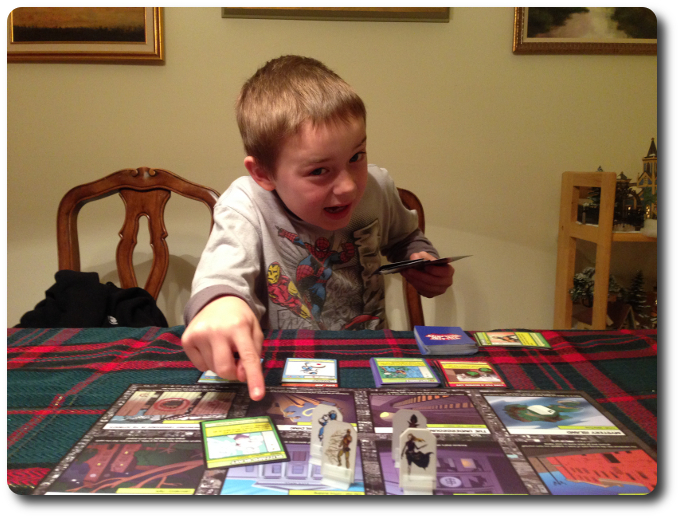
My “Hero” 8-year-old slaps down his attack and announces that he is going to kick my butt
The Parent Geeks found the game to be more difficult than they thought. According to one Parent Geek, “Moving about the City, getting the right cards, confronting your enemy, and keeping track of your missions is a lot to juggle.” It can be, but none of the Parent Geeks felt overwhelmed. They did feel a bit underwhelmed at times, however. As one Parent Geek put it, “Sometimes I just don’t have the cards I want and I’m forced to reshuffle. Or worse yet, I have too many cards with too many options, which doesn’t help me decide what I should do.” This feast or famine was rare and only lasted a turn, but it was enough to get the Parent Geeks to grumble. Even so, they found Villains and Vigilantes to be fun and fully approved it.
The Game Geeks were very pleased with the game. According to one Gamer Geek, “A surprisingly strategic and tactical game. There’s a lot more depth here than I thought and I’m really digging how players have to move about and use the cards. This is a great game.” Another Gamer Geek said, “Most card based games can hold a player hostage if the right cards aren’t available, but the player is never without cards to play with.” And yet one other Gamer Geek said, “I don’t care for games with superheroes, but this is a game I really enjoyed.” All the Gamer Geeks found Villains and Vigilantes to be a game well worth their time and a lot of fun to play. They fully approved the game without hesitation.
I was pleasantly surprised with Villains and Vigilantes, too. It was much more tactical and strategic than I originally thought and the game’s them was strong throughout. All of our players enjoyed themselves, even if some were frustrated at times. I believe the frustration, however, was caused by the Location board that represented the City. If Villains and Vigilantes was a game that only included cards, then time and distance would be dissolved into an abstract value with little meaning other than timing to resolve actions. As the game is today, if I’m currently occupying a Location in one corner and I see trouble happening in a remote portion of the City, I now have to calculate the physical distance of the move, sacrifice cards to get there, and hope I have enough left to put up a fight. That was really cool, but it can also be frustrating as players might not have the cards they need to do what they want. The resolve this, a player need only have a bigger team to cover more area.
The game gave our players a lot of choices. Too many in some cases and not enough in others, but I believe these to be edge cases. I have never observed another player being stuck or overwhelmed with options. The cards balance themselves out, giving ample opportunity and reduction in ability. It’s a game designed that worked really well and was a lot of fun to play with.
Speaking of balance, the customization of existing decks and building of new ones is well thought out and flat-out fun. The rules are rigid, but not to a point where they reduce creativity and freedom. The amount of theory crafting is reduced, but is replaced with a lot more combos and possibilities. I was able to create a brand new deck within 15 minutes and had another 5 days of entertainment of just adjusting it. By the time I was finished, I felt like I had a Super Villain team that was fully my own.
Here is a game with enough depth to make you feel comfortably submerged in the game play, complex enough to challenge a player’s strategic and tactical thinking, and yet casual enough to be welcoming to new and inexperienced players. The only place where the game falls down a bit is the cards, since some of the effects are a bit ambiguous, but all it takes is some thought and the moment of confusion is gone. Do try this game if you are a fan of superheroes, customized deck building games, and tactical thinking. You might just find it to be “super”.
This game was given to Father Geek as a review copy. Father Geek was not paid, bribed, wined, dined, or threatened in vain hopes of influencing this review. Such is the statuesque and legendary integrity of Father Geek.



